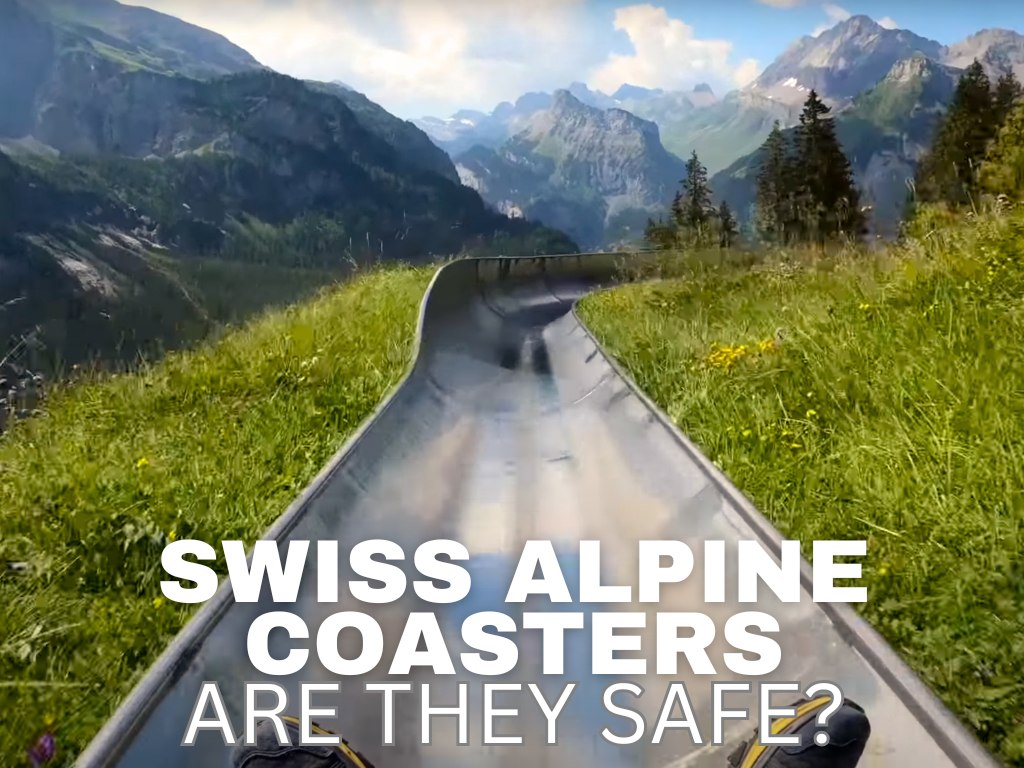Switzerland’s alpine coasters — or summer toboggan runs — are a fun and unique way to race through the mountains. And a great way to experience Switzerland when you are here.
Winding steel tracks, sweeping curves, and gravity-powered acceleration make them a popular family attraction in resorts from Interlaken to Gstaad.
But recent accidents have made me take a deeper look at this industry, to make sure my readers and clients can always stay safe while in the Swiss Alps!
👉👉 SEE MY LIST OF THE BEST ALPINE COASTERS
A Track Record with Trouble

In July 2025, a 35-year-old employee was tragically killed while testing the popular toboggan run in Matten, near Interlaken. The details of the incident remain under investigation, but it marked the fourth serious accident at this particular track in just over a decade.
Matten’s coaster is not alone. In 2008, a Canadian tourist lost her life on the alpine coaster at Glacier 3000, near Gstaad. Poor visibility, wet conditions, and inadequate safety oversight were cited in the court ruling that followed. The ride operators were later found guilty of negligence.
Keep in mind these are quite isolated incidents and should not tarnish the whole industry, but they should make you aware that dangers exist and you should take care when using these facilitiesy.
Numbers Behind the Thrill

According to Switzerland’s national accident insurer SUVA, around 130 people are injured each year on summer toboggan runs. Now, those are not all severe accidents. That figure includes broken bones, concussions, and — in rare but serious cases — spinal trauma.
To put that into context, let’s compare with another quite dangerous pastime – snow sports!
Switzerland recorded around 14,000 snow-sport accidents during the winter 2023/24 season, with 4% of those linked to sledging-type incidents, including toboggans (SwissInfo – March 2024).
This is four times the accident rate with toboggans in winter!
Why Accidents Happen – And How To Avoid It
Many accidents involve rider error — failing to brake in time or following too closely are some of the most common and avoidable.
Want To Save This For Later?
But, several also point to design shortcomings. Many Swiss alpine coasters are built with basic lap belts and minimal restraints. Riders sit low to the ground, often without a backrest or shoulder support, and speeds can reach 40 km/h. So, always take it easy on these things, as they are not designed to save your life like a car is.
Collisions also occur when one cart slows or stops unexpectedly and the rider behind can’t brake in time.
LESSON 1: Always keep a safe distance and watch the rider in front of you.
LESSON 2: Always maintain a speed you are comfortable with and can safely corner with. Have a few rides to get a feel for the speed, braking and cornering before going too fast. It can quickly get our of control.
I don’t want to put you off Alpine Coasters. I have been on many. But I have a lot of experience at speed (skiing, mountain biking) and know my limits and also know to watch out for other less confident and capable drivers! That is the key.
👉👉 SEE MY LIST OF THE BEST ALPINE COASTERS
Staying Safe in the Mountains
So should you skip the summer coaster altogether? Not necessarily. For the vast majority of riders, the experience is safe, fun, and scenic. But it pays to be cautious:
- Always leave plenty of space between you and the rider in front.
- Don’t slam the brakes unless you absolutely have to.
- Avoid riding in rain or fog, when visibility and stopping power are reduced.
- Use both hands and stay seated upright for better balance and control.
- If you have back, neck, or bone conditions, consider skipping the ride.
Most importantly, pay attention to signage and follow all operator instructions. While the risk of severe injury is relatively low, even minor crashes can ruin your day — or worse.
So, stay safe, have fun, but don’t let things get out of control!
A Ride Worth Respecting
Swiss alpine coasters are a testament to the country’s creativity in mixing natural beauty with engineered fun. The rides offer unmatched views and a dose of mountain adrenaline. But they’re not risk-free.
So ride — but ride with care.


